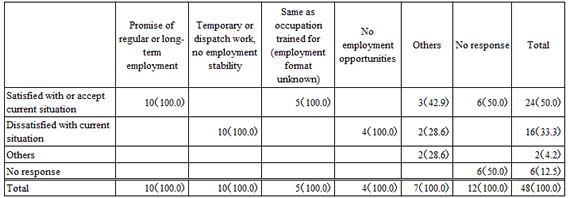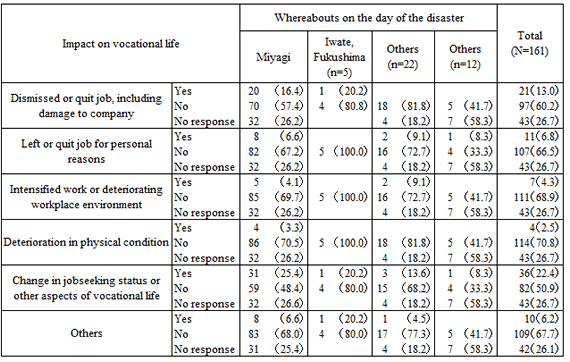JILPT Research Report No.162
The Great East Japan Earthquake and Sites of Vocational Training:
Records of the Miyagi Polytechnic Center, from the Disaster to Recovery and Reconstruction
(JILPT, Compilation of the Results of the Project to Record the Great East Japan Earthquake No.7)
March 14, 2014
Summary
Research Objective
During the Great East Japan Earthquake disaster, Miyagi Polytechnic Center (Human Resources Development Promotion Center) suffered damage both from the earthquake itself and from the resultant tsunami, forcing the complete suspension of vocational training and partial closure of the facility. This report summarizes the post-disaster response, subsequent rebuilding of livelihoods, and reconstruction training. Data are mainly sourced from questionnaires targeting (1) staff and trainees at the time of the disaster, and (2) staff and trainees during recovery and reconstruction after the disaster.
Research Method
Interview survey (survey period: July-August 2012) and questionnaire survey conducted by Miyagi Polytechnic Center (survey period: August 2012)
Major Findings
Miyagi Polytechnic Center managed to prevent damage threatening human life between the occurrence of the disaster and the subsequent recovery. It achieved this by resolving, one by one, issues that arise in stages with the passage of time from the occurrence of a disaster to reconstruction. Action was taken quickly with the aim of restoring the status immediately prior to the disaster (= recovery), both for individuals and for the organization as a whole.
Although disaster damage caused the closure of the Miyagi Polytechnic Center and suspension of vocational training, trainees who then entered stable employment, or were employed in the same occupation as they had been training for, expressed a sense of acceptance and satisfaction with their subsequent employment (Figure 1). Just under 21% of these trainees entered stable employment, but the survey results revealed that, rather than the ease of gaining employment, there was a greater desire for training subjects and courses for disaster victims to concur with the image of recovery held by the victims.
Meanwhile, some 20% of those who had been in work at the time of the disaster and then started vocational training at the Miyagi Polytechnic Center had lost or quit their jobs as a result of the disaster (Figure 2).
Figure 1. Present employment status (Unit=persons, ( )=%)
Figure 2. Impact of the disaster on vocational life (Unit=persons, ( )=%, MA)
Policy Implications
When setting training subjects and courses on the assumption of supporting disaster-affected areas and disaster victims after a disaster, they should not only be based on the prospects for supply and demand on the labor market, but also be so assembled as to incorporate the recovery wishes of disaster victims and disaster-affected companies. In disaster-affected areas, meanwhile, steps need to be promptly taken to prevent secondary damage, in awareness that the state of disaster damage still continues over the long term from the date of occurrence.
Policy Contribution
Disaster response and reconstruction efforts are presented through the eyes of people in sites of disaster damage. In future, this will serve as basic information for ensuring the safety of society.
Contents
- Cover – Preface – Authors – Contents
- Part 1 Survey Summary
- Part 2 Survey Summary
- Appended tables
Research Categories
Project Research “Survey Research on Directions for Strategic Labor and Employment Policies Including Measures for Non-Regular Workers”
Subtheme “JILPT Research Project on Recovery and Reconstruction, Employment and Labor after the Great East Japan Earthquake (Project to Record the Great East Japan Earthquake)”
Research Period
FY2012-2013
Author
- Mari OKUTSU
- Project Researcher, Japan Institute for Labour Policy and Training



